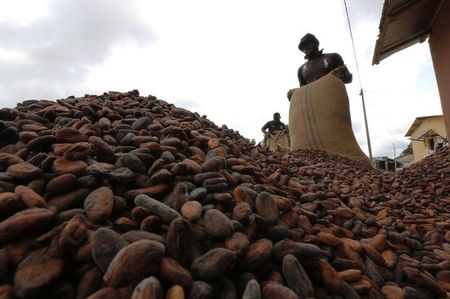By Lewa Pardomuan and Marcy Nicholson
SINGAPORE/NEW YORK Sep 5 (Reuters) - Chocolate makers in the fast-growing Asian market are replacing a bigger proportion of cocoa butter, which gives confectionery its melt-in-the-mouth texture, with cheaper palm oil-based alternatives.
The move will help confectioners keep down prices in the price-sensitive region where chocolate sales are forecast to grow more than 5 percent this year to about 917,000 tonnes, according to market researcher Euromonitor International.
This is well ahead of growth of less than 1 percent in the United States and about 1.5 percent in western Europe.
Palm oil-based butter mimics the taste of cocoa butter but is much cheaper. Higher demand for butter alternatives, known as cocoa butter equivalent (CBE), has pushed prices up by about 10 percent to $3,300 a tonne in the past year, but this is still more than $4,000 below the price of butter from cocoa beans.
"We don't normally buy CBE, but now we use it because of requests from customers," said Richard Lee, chief executive officer of Aalst Chocolate, a Singapore-based firm that sells chocolate to bakeries, ice cream makers and food manufacturers.
"When butter prices were low, we didn't even use CBE at all," said Lee, who estimated that the firm's orders for substitutes were three to four times higher than last year.
Confectioners in Asia and Europe are allowed to add cocoa butter equivalent to chocolate, but hold the maximum amount at 5 percent since a higher content can alter the taste and put off customers. In the United States, products using butter alternatives cannot be labelled "chocolate".
COCOA BUTTER PRICES SURGE
Cocoa beans are processed into roughly equal parts butter and powder, which is used in cakes, biscuits and drinks.
Chocolate typically contains about 20 percent cocoa butter, so confectioners in Asia and Europe looking to save money can replace about a quarter of the cocoa butter with something else.
"The whole thing is about affordability - there's no point in paying so much," said Mohammad Jaaffar Ahmad, chief executive of the Palm Oil Refiners Association of Malaysia.
Cocoa butter prices jumped 28 percent this year to as high as $8,200 a tonne on strong demand and tight supply after global grinders cut processing to reduce inventory.
The world's capacity for making cocoa butter substitutes of all grades is now about 150,000 tonnes per year, up by 25,000 to 30,000 tonnes since 2013, according to an industry source.
The rise in the price of palm oil-based cocoa butter substitutes has come even as palm oil prices have fallen to five-year lows, underlining the increased demand for the product.
The largest market for vegetable fats in chocolate is countlines, bitesize chocolate bars eaten as snacks, although some of this will be used in the fillings rather than the chocolate itself, according to Euromonitor International.
Nutritionists say both products may be equally bad for you.

"They are both high in saturated fat and will raise total cholesterol, and I would expect that there would not be a great difference from a health perspective," said Walter Willett, professor and chairman of the Department of Nutrition for Harvard School of Public Health in Boston.
(Additional reporting by Anuradha Raghu in Kuala Lumpur; Editing by Ed Davies and Richard Pullin)
